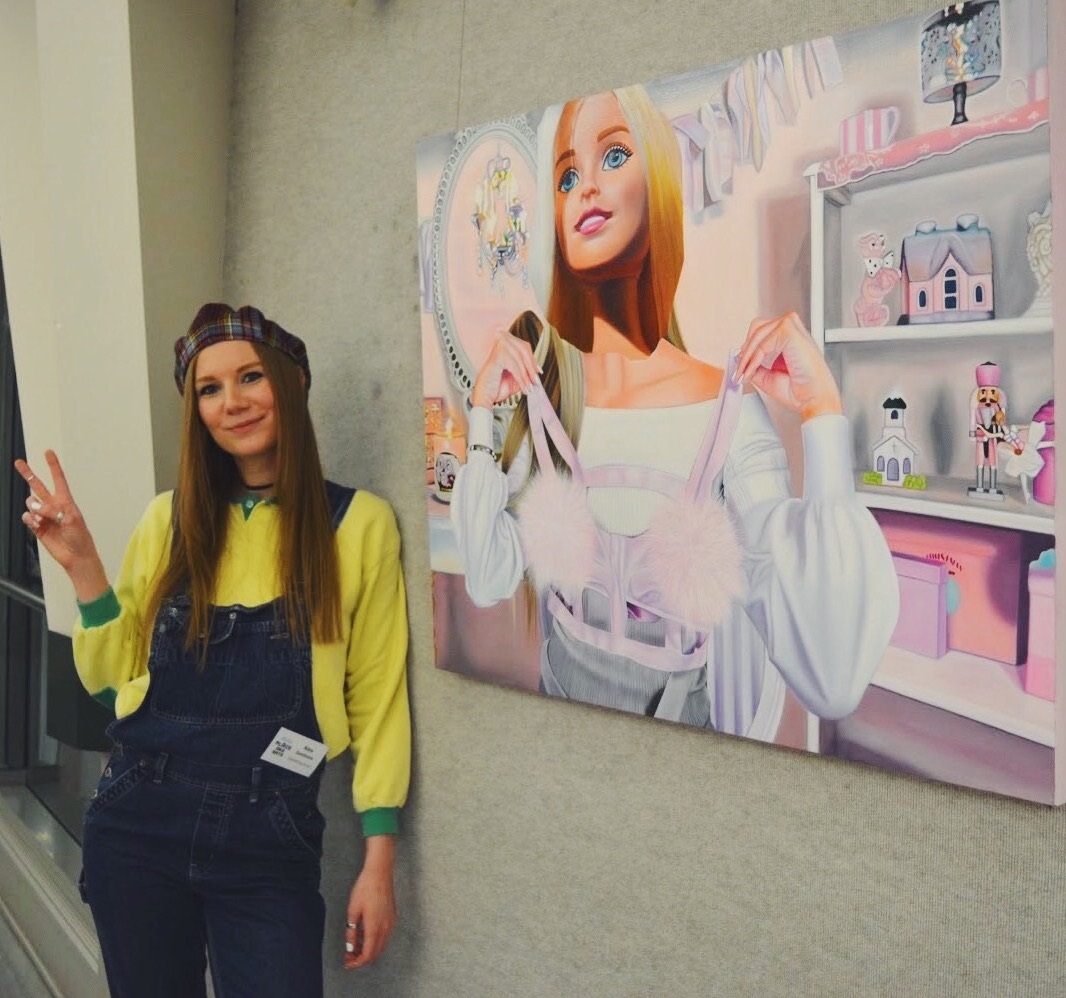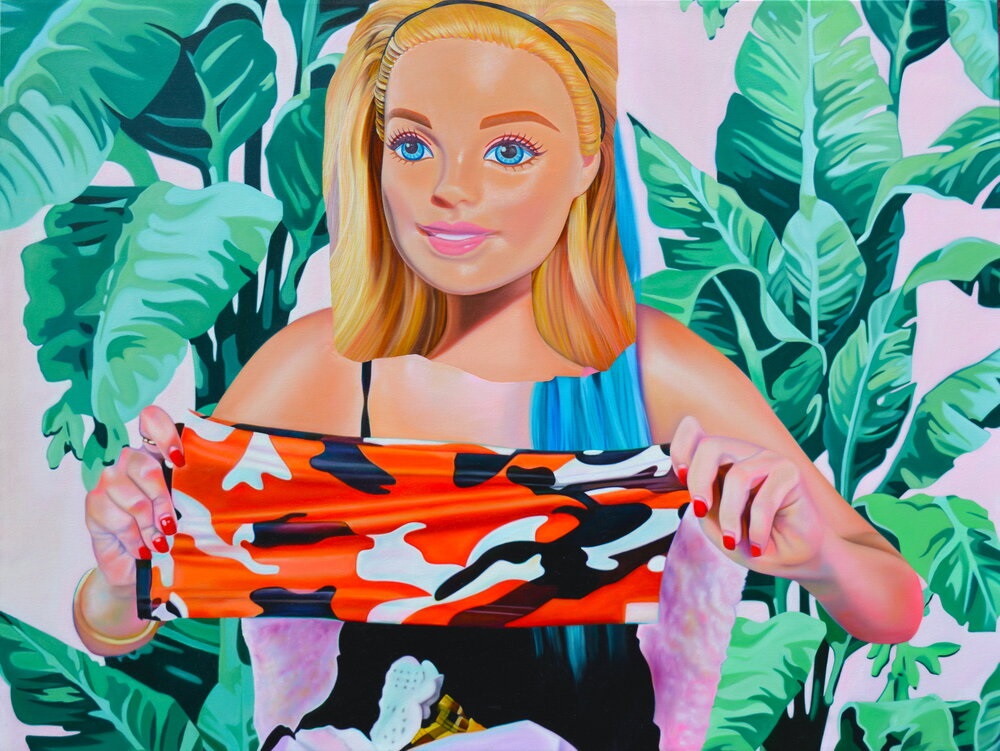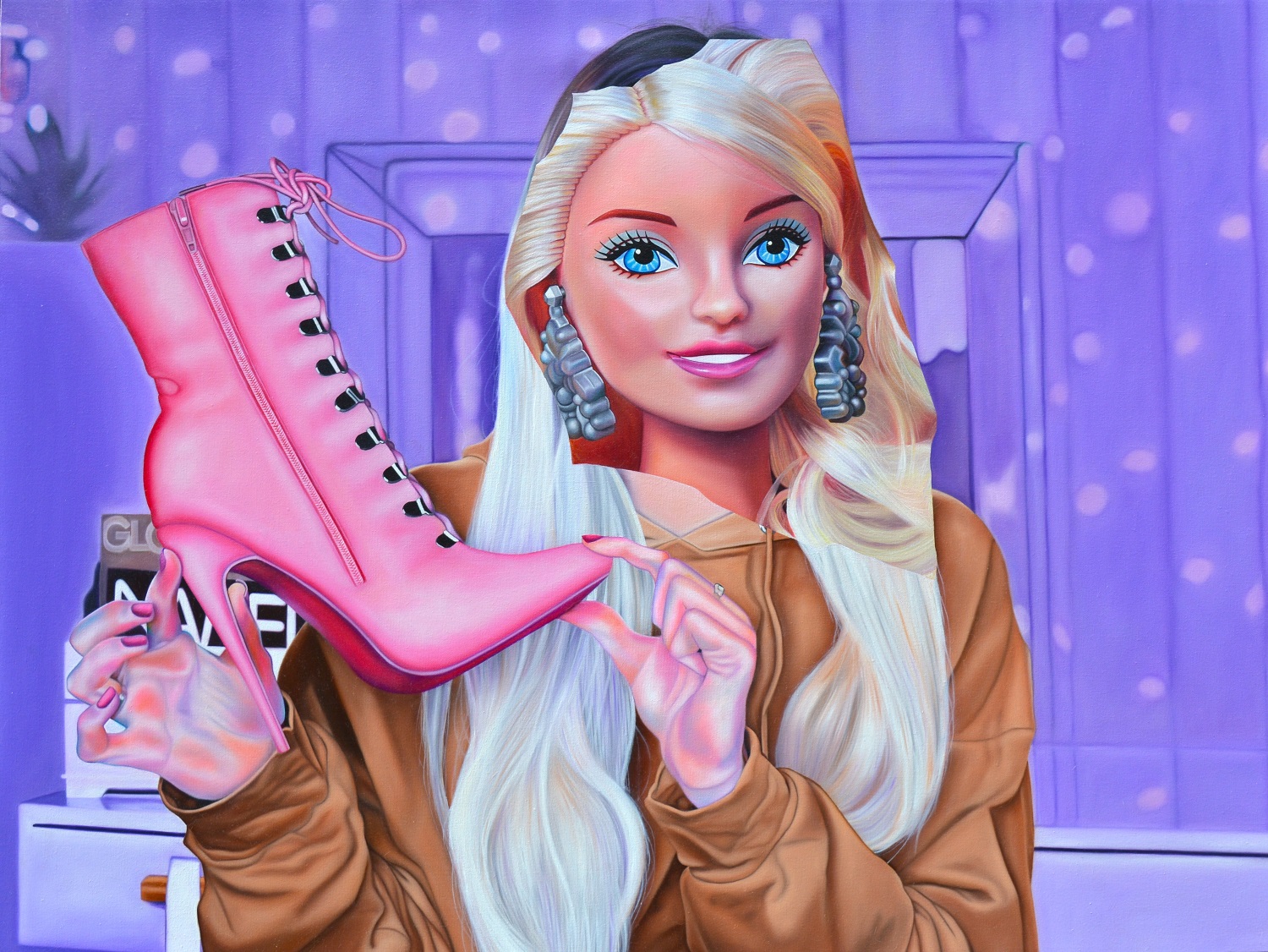In 16th century Italy, Renaissance masters like Raphael painted Madonnas.
In 21st century Surrey, Alex Sandvoss is turning an idol of her time, the social media influencer, into satirical art.
“They’re inescapable,” she said. “You go online and they just show up.”
Social media influencers have followings in the thousands and millions. They are personalities on platforms like YouTube and Instagram, broadcasting anything from makeup tutorials to travel diaries to their latest clothing haul.
If you happen to be an influencer with a unique voice and dedicated following, a company might give you free products to review, or sign you on to become a brand ambassador.
Sandvoss began her series of paintings, called The Influencer, about a year and a half ago, collecting screenshots from influencers preaching products and lifestyles on YouTube and recreating them on canvas.
She renders them in great detail, with messages of consumption crammed into every inch of the frames, from the glossy patent leather on stilettos to the fluffy pompoms of a cage bra, all of it set in bedrooms where mirrors and chandeliers are part of a carefully curated backdrop.
It’s a rare invitation to ponder the content that comes at us around the clock on our social media feeds.

As for influencers’ faces, we can’t see them. There’s a cutout of Barbie’s head, as if snipped from some fan magazine, pasted overtop. Sandvoss is in stride with artists like Andy Warhol and Cindy Sherman that looked to the all-American dress-up doll as muse.
“Barbie is kind of that capitalistic heroine,” said Sandvoss. “To me, she’s an iconic symbol of narcissism, vanity and solipsism, that whole plastic culture. I wanted to show that super individuality blocking out authentic humanity.”
It’s not important who the depicted influencers are, she adds, because “everyone’s complicit” in keeping the machine running: the influencer, but also the viewer.
In half of the paintings from her series, Sandvoss brings these modern Narcissuses further into the past, satirizing medieval and Renaissance works with Barbie’s head imposed over the Madonna herself.
A “recasting,” she calls it, to show how the self and materialism have become the new worship.
(Pope Francis himself, in a stranger-than-fiction tweet from last year, made the connection between mother Mary and influencers. The Holy Father tweeted that Mary, without the aid of any social networks, was able to become “the first ‘influencer’: the ‘influencer’ of God.”)
Painting was never something Sandvoss intended to do professionally, just a hobby while she pursued a music degree at McGill University.
Upon returning to B.C. after graduation, she got a job at Opus Art Supplies in downtown Vancouver and was inspired to work on her first project, portraits of people from the streets of the Downtown Eastside. (Two works from The Faces We Pass By Every Day are on display at the YVR airport.)
“It was about people society decides to ignore, homeless and low-income people,” she said. “It was about making sure that we value connection and not leaving people unseen.”

No cage bras dangled in that series — Sandvoss draws you into moments with the people you might pass by on the sidewalk, with intimate attention to eyes and beloved ball caps.
“Then I did a 180 and asked: who are the people at the centre of attention?” Who else for her generation but the influencers?
The Influencer debuted at Coquitlam’s Place des Arts in January, but a number of subsequent exhibitions, such as at South Asian Fashion Week, were cancelled due to COVID-19.
Still, the art is timely as ever, considering that we’re likely to spend more time on our screens during the pandemic.

‘This series is so much about frivolous desire’
If you’re in your 30s, your first encounter with an influencer was likely a blogger. If you’re in your 20s, a YouTuber. If you’re in your teens, an Instagrammer or TikTok personality.
Celebrity endorsements have long been around, but social media has led to the creation of a new kind of famous person.
Unlike people like Beyoncé and Kylie Jenner, already beloved to begin with and with Instagram followings in the multimillions, social influencers often have no history of fame aside from their online presence.
In an age where anybody can plug into a social media platform, marketers can also pluck anybody meeting their criteria to be their champion
And with social media offering direct access to an influencer, oftentimes with views into their bedrooms and family lives, there’s the added allure of intimacy and authenticity.
“You see how many millions of views these people are getting, because it’s all underneath [the video],” said Sandvoss. “And being able to put into perspective just how much attention they’re getting is disturbing.”
As the Guardian writes, “Influencers now have their own line on a brand’s marketing-spend spreadsheet alongside TV, radio.”
But not all influencers are on contract with companies. Some are happy to receive a few free products to review, while others churn out content for nothing at all. Their content ranges from make-up tutorials, motivational monologues, travel diaries, storytelling to celebrations of shopping.
The 2018 film Eighth Grade — written and directed by Bo Burnham, a YouTube star himself catapulted to the professional world of entertainment — depicts the desire of a middle-schooler to make it as a motivational influencer, creating videos that get little to no views online.
Sandvoss said watching the influencers who peddle their wares for the project had a “mindless, Kool-Aid” effect, and she can see how people get “this weird desire to go out and buy stuff.”
Sandvoss is as careful with what she wears as she is with how she paints, often reading about the environmental effects of fast fashion.
She shared many frightening facts in our interview, such as that 7,500 litres of water are required to make a single pair of jeans, or that 80 to 90 per cent of donated clothing at secondhand stores is thrown away or shipped off to developing countries.
“I don’t love wearing things that have logos on them,” Sandvoss said. “I know that sounds so extreme, but I shy away from them. I don’t want to be a billboard for a company.”
With the exception of shoes, which are harder to shop for secondhand, Sandvoss hasn’t purchased new clothes in four years, her own way to try and influence a better world.
Earlier this year, she was invited to two high schools, including the one she attended in south Surrey, to chat about her art with the very demographic that does not know a world before smartphones and social media.
A psychologist warned in the Guardian that platforms like Instagram are taxing the mental health of young people, giving them a “false sense of what the average is.”
Thankfully, the students Sandvoss spoke to were critical about the content they consume.
“I felt such optimism for the future,” she said. “They thought some of this stuff was ridiculous. And rather than focusing on stuff that can be damaging to self-perception, they said we can find role models who align with our values.”
With COVID-19 slowing consumption, she hopes it will prompt a rethink of spending habits.
“This series is so much about frivolous desire,” said Sandvoss. “Now, with the situation we’re in, there are different wants and needs. With shopping trips limited, money being tight, and not having the same access to things as we did before, I hope it shows the importance of human connection.”
You can view more works from 'The Influencer' on Alex Sandvoss’s website here, and follow her on Instagram here.
Read more: Gender + Sexuality
















Tyee Commenting Guidelines
Comments that violate guidelines risk being deleted, and violations may result in a temporary or permanent user ban. Maintain the spirit of good conversation to stay in the discussion.
*Please note The Tyee is not a forum for spreading misinformation about COVID-19, denying its existence or minimizing its risk to public health.
Do:
Do not: